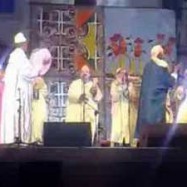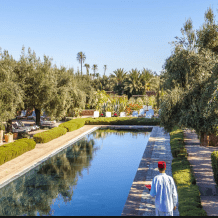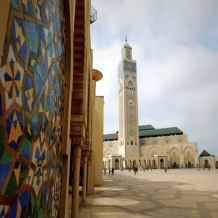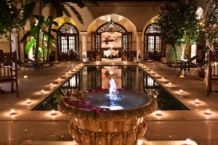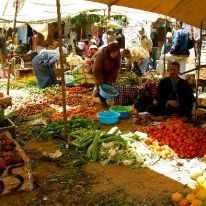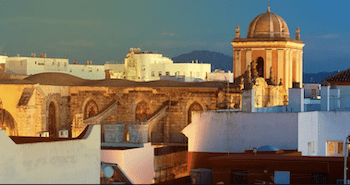
24 Hours In Tarifa, Andalusia’s Little Morocco
Located just 40 minutes by ferry from Morocco’s port city Tangier, Tarifa is Europe’s southernmost city and a gateway to the North African continent. It is across from the Strait of Gibraltar and faces Morocco. This small fishing village is located in the province of Cádiz, Andalusia. Tarifa is one of the popular towns for wind sports, particularly surfing and has been influenced by the Moors, people of Arab, Spanish and Amazigh origins.
Many travelers who visit Morocco use Tarifa as a starting or ending point for rest and relaxation. Exploring Tarifas beautiful beaches and old town makes for the perfect two-day adventure before or after a Morocco Private Tour. Tarifa is home to many architectural gems worth visiting.
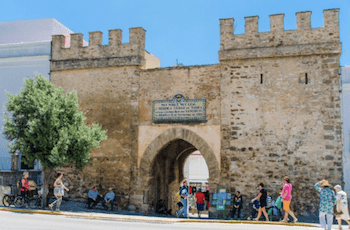
Tarifa’s Historic Monuments
Castillo de Guzmán el Bueno – On the southern edge of the old town sits Castillo de Guzmán el Bueno which was constructed by the Caliph of Córdoba in the 10th century.
Puerta de Jerez – One of four medieval entrances still standing, the Puerta de Jerez from the 9th century is the entrance to Tarifas historic old town. This gate boasts a horseshoe arch that at one time opened onto Jerez de la Frontera. Upon entering the ancient walls of Tarifa, you will see a plaque dedicated to Sancho The Brave, the Christian King who sacrificed his son to regain Tarifa from Moorish conquest in 1292. As the gateway to the old town, visitors who pass through it will be guided down the cobbled hilly streets moving to the basin of the historic district. White washed buildings line the streets with many bespoke and local cafes where tapas, coffees and local Moorish inspired sweets can be enjoyed.
Castillo Santa Catalina – Built in the 1930s this watchtower was constructed in Italian Renaissance style. Poorly damaged in World War II, this tower is closed yet well positioned with views.
Igelsia de San Mateo Church – Built in the 16th Century on the site of a former mosque, this historic church was named after the Christian king who took Tarifa from the Moors in 1292.
Iglesia San Fransico de Asis – Built in the late 16th century this church is the home to the first baptism in Tarifa. It boasts both Baroque and Neoclassical styles in its architecture.
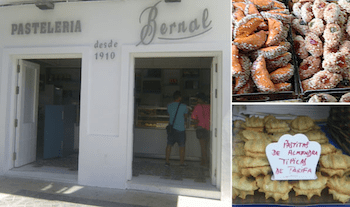
History: Morocco, the Moors, and Tarifa
Tarifa was founded by the Romans in the first century.This Andalusian town has a strong connection with Morocco. Islamic architecture found throughout Morocco is present in Tarifas monuments, buildings, tilework and stylistic geometric patterns.
Tarifa is named after Tarif Ibn Malluk. Malluk was a Berber chief who accompanied Tarik ben Zeyad the Arab leader who defeated Don Rodrigo at the battle of La Janda in 711.
Other historical connections between Morocco and Tarifa can be traced back to several periods in the timeline between the 10th century and late 13th century. Tarifa’s Caliph Fort was built by the order of Aberraman III in 960, the Almoravids began the conquest of Al – Andalus in 1085; 1147 was when the the Almohads arrived, and until 1231-1292 the Merinids ruled Tarifa until it was taken from the muslim by Sancho IV of Castile.
Tarifa also has similarities to the to the coastal towns of Tangier and Essaouira. The weather conditions of Tarifa are similar to the port city of Essaouira well known for attracting kite surfers and wind surfers. The historic medina of Essaouira also resembles that of the old town in Tarifa. Hotels, restaurants and buildings in Tarifa are built inside or near the old town’s ancient walls that offer a glimpse into the Moorish past.
Bakeries Serving Moroccan Pastries
There are 2 pastry shops in Tarifa with Arabic influences. Tarifena, the bakery closest to Puerta de Jerez (Ntra. Sra. de la Luz, 21 ) and Pasteleria Bernal serve up some of the best Arabic sweets in Andalucia. The common ingredients in all these pastries are almonds and a touch of orange de fleur. Try the kaab al ghazal or gazelle horn; it is shaped like a half moon and filled with almond paste. You can also find the pastela at Bernal ( Calle Sancho IV el Bravo, 3). The Pastela, a contrast between sweet and savory, is found all over Morocco and especially famous in the city of Fes; it is filled with meat, onion, almonds, and cinnamon.
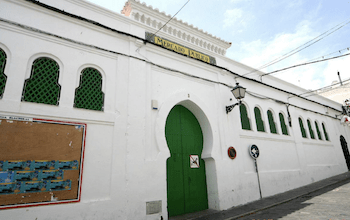
Mercado Publico de Tarifa
Another architecturally relevant building to visit is the Mercado Public de Tarifa. Upon entering you will be struck by how the architecture holds Moroccan Arabic touches. Vaulted arches, an open air riad like rooftop, and geometric pattern ceramic tile work are to be found. The lively morning market sells the local catch of the day, produce from the surrounding farms. There is also an indoor sitting area where you can order a coffee; buy a combination of meats, cheeses, and bread from the surrounding vendor chuchuteries and have yourself an on-the-spot picnic. Calle Colón, 5. Open 9 am to 3pm, every day except Sundays.
Boutiques, Tarifa meets Morocco
Tarifa attracts an international mix of designers, artists, entrepreneurs and writers from around the world. There is a wide range of boutiques selling African and Moroccan inspired textiles, bags and accessories. Some of the boutiques change seasonally, but the main shopping streets are on Calle Ntra. Sra. de la Luz; Calle San Francisco, 8 and the plaza around Calle Sancho IV el Bravo. One new shop not to miss is Ocra: you’ll find 100% soft cotton kaftan like dresses, wide legged trousers and loose yet tailored tops. Ocra is a store that hits the mark on a mix of modest and contemporary fashion. They also sells a great collection of soft leather hand bags and travel luggage. Calle Ntra. Sra. de la Luz
Tarifa’s Historic Wall
After exploring the old city of Tarifa, travelers can continue to explore the 500 meter wall that surrounds the perimeter of Tarifa’s old town. On a clear day there are several look out points along the port to have coffee or tea while viewing the majestic views on the tip of North Africa.
Arguably, the best place to see the coast of North Africa is from the Torre de Miramar. To find this historical landmark, visitors can walk along calle Amargura and climb the steps to the plaza where the famous tower sits. You will see a long stretch of African palm trees, benches covered with Moroccan ceramic prints and in the far left corner is the Plazuela Del Viento. This windy corner is nicknamed the “thinking spot,” perfect for taking in Atlantic Ocean views along with Tarifas hiking landscape. For the best views of Morocco, you can climb the Torre de Miramar steps.
Casino, Carcel Real, Plaza De La Fuente
After indulging in the best views of North Africa, visitors can continue to explore the Moorish influenced buildings and architecture. Around the corner from Torre de Miramar is Plaza de Santa Maria.
Plaza de Santa Maria is famous for it’s courtyard surrounded by bitter orange trees, the Plaza De Las Ranitas (a frog fountain) and a Moorish looking library. These characteristics are perfect examples of how the Moor’s left their mark on Tarifa and Andalucia. Bitter orange trees can be found in Morocco’s gardens and are used in Moroccan hammams. Bitter oranges were originally brought by the Arabs from China to Valencia. The water fountains found throughout Andalisia, Spain are also attributed to the Moors as they introduced their advanced water technology to Spain because it was an important practice for them to wash their hands and feet before prayer, which they did five times a day.
Plaza de Santa Maria and other central squares in Tarifa are lined with geometric patterned ceramic benches. The ceramic geometric patterns found on benches, the edges of doors and window along with all decorations all show the Moorish presence. In the Mosques, iconography was not forbidden however it was more typical to see ornamental patterns, geometric, vegetal, animal motif, leaves or palmattes.
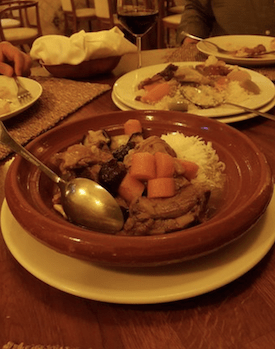
Restaurants with Moroccan Influence
Tarifas cafes and restaurants have a few Moroccan inspired menus. One restaurant known for Moroccan gastronomy and perfect to prepare your taste buds for Tangier is Mandragora. The restaurant serves couscous, arguably the most famous dish in Morocco and a great option for vegetarians. Couscous is served with a choice of meat and vegetables yet also available with only vegetables such as carrots, caramelized onions, potatoes, cabbage, and garbanzo beans. Traditionally, couscous takes up to 4-5 hours to make and it typically eaten on Fridays after prayer and in local villages each evening. Popular ways to eat couscous is with lamb, beef, or chicken. Couscous is traditionally flavored with Moroccan spices such as Ras el hanout, Cumin and some recipes include cinnamon.
Other Moroccan items on Mandragora’s menu are kefta (beef) and tajine. Tajine by itself is not a meal but rather refers to the cone shaped lid where an appetizing stew made with vegetables, fish, or meat is cooked. It is common to enjoy a steaming cup of mint tea after your meal. (c/ Independencia, 3; +34 956 68 12 91 )
Another exciting opportunity to try Moroccan food in Tarifa is at Souk, a restaurant whose menu fuses Arabic, Indian and Thai flavors. Also available to order are Moroccan pastries for parties and events. (c/Mar Tirreno, 46; +34 956 62 70 65)
Flamenco Music at Al Medina on Thursday Nights
On Thursday nights, inside the ancient Arabic Walls of Tarifa, the tapa and cocktail bar Al Medina, hosts live evening Flamenco Music. A Moorish arched entrance, cozy corners, Moroccan lanterns and intimate lighting are the Moorish design touches found inside Al Medina. The performances are by local Flamenco singers and free of charge. The establishment serves a wide assortment of Spanish wines. ( Calle Almedina, 3). When you arrive in Tangier, you can enjoy a another unique fusion of Andalusia and Moroccan music. Les Fils du Detroit, a small band of local Musicians fusing Arabic and Spanish instruments at their live jam sessions for 42 years.
Recommended Book to Read Before Visiting Tarifa: The Alchemist
The Alchemist, by Paul Coelho, is a story of Santiago, a boy who embarks upon a journey to find his true life’s purpose. The Alchemist is set in Tarifa, ferries over into Tangier then down into the Sahara desert. The story chronicles Santiago’s fearless attitude, challenges, and resolute determination to follow his heart. If you are staying in Tarifa, The Alchemist is an inspirational and fun to get you ready for your Morocco adventures.
Ferry To Tangier
The ferry from Tarifa to Tangier is a short 40 minute ride and takes you into Tangier Ville. The schedule changes based on the time of year, however, assuming the sea is calm, the ferry runs every 2 hours from 9am to 11pm daily. If weather does not permit using the ferry from Tarifa to Tangier, another option is to catch a ferry from the port in Algeciras. Travel time is 1.5 hour to arrive to Tangier Med however the boats at the port of Algeciras are larger and usually run despite strong wind or rain. To get to Algeciras from Tarifa, it take a 25 minute bus ride. The ferry schedule from Algeciras starts from 3 am and goes until midnight; ferries run every 3 hours. Both Tarifa and Algeciras have several private vendors selling ferry tickets. If possible buy your ticket from the public office or online at https://www.directferries.co.uk The average cost of a ticket is 30 Euros.

